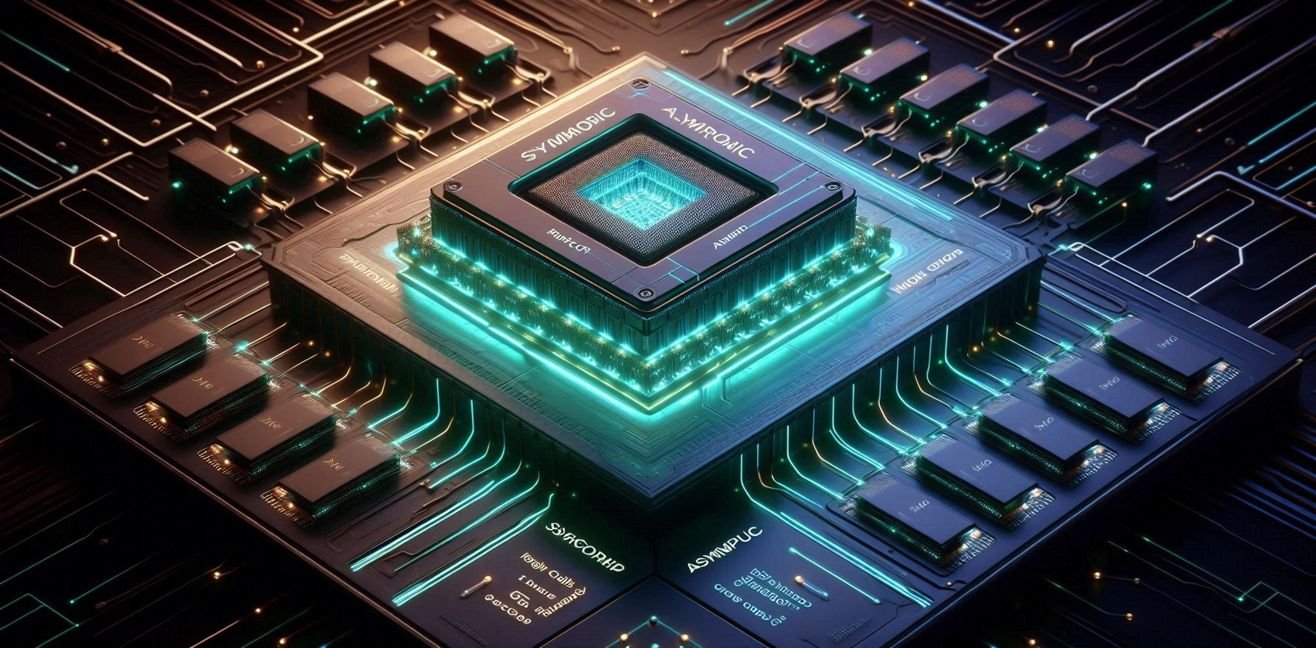First, the basics: Multiprocessing is when multiple processors (or cores) work at the same time. The goals are:
- Higher performance 💨
- More parallelism ⚡
- Better resource utilization
In the past, CPUs were single-core. One processor handled the entire workload, like a village headman organizing all the weddings alone. But data grew, AI arrived, games became massive… and the headman couldn’t handle it alone anymore. The solution: multicore CPUs.
🟢 Symmetric Multiprocessing (SMP)
Symmetry here means “everyone is equal.” All processors are at the same level:
- They access the same memory (shared memory).
- They can perform the same tasks.
- They are treated equally by the operating system.
📌 Technical Features:
- Shared Memory Architecture: All CPUs use the same memory.
- Cache Coherency: Cores must synchronize their caches. This is achieved with protocols like MESI.
- Load Balancing: The OS distributes tasks evenly across cores.
📊 Advantages:
- High flexibility: any core can take on any task.
- Easy programming: transparent for the developer (the OS handles it).
- Modern operating systems (Linux, Windows, macOS) support SMP.
⚠️ Disadvantages:
- Memory access can become a bottleneck.
- Extra cost for cache coherence traffic.
- Complexity increases as the number of cores grows.
📌 In short: SMP = A shared kitchen where everyone dips their spoon into the same pot.
🔴 Asymmetric Multiprocessing (AMP)
Asymmetry here means “boss–worker relationship.” One core (master) manages tasks, the other cores (slaves) execute them.
📌 Technical Features:
- Master CPU: Handles the operating system and scheduling.
- Slave CPUs: Only execute tasks assigned by the master.
- Memory access is usually through the master.
📊 Advantages:
- Simpler hardware and software design.
- Less coordination overhead.
- Lower power consumption in embedded systems.
⚠️ Disadvantages:
- Dependence on the master: if the master fails, the system crashes.
- Efficiency may drop: slave cores might stay idle.
- Not suitable for complex workloads.
📌 Example: ARM’s big.LITTLE architecture → High-performance big cores + energy-efficient LITTLE cores in smartphones.
🔗 Tightly Coupled vs. Loosely Coupled
Multiprocessing isn’t just about SMP vs. AMP. The connection between cores is also critical.
1️⃣ Tightly Coupled Systems
- CPUs directly access the same memory.
- A single operating system is used.
- Very low latency.
💡 Advantages:
- Fast data sharing.
- Excellent for parallel computing.
⚠️ Disadvantages:
- Increased memory traffic.
- Synchronization becomes harder as CPUs increase.
📌 Example: Multicore CPUs in laptops/desktops we use daily.
2️⃣ Loosely Coupled Systems
- Each processor has its own memory.
- Communication happens through “message passing.”
- Works more like distributed systems.
💡 Advantages:
- More scalable: thousands of processors possible.
- No memory contention.
⚠️ Disadvantages:
- Message passing = latency.
- Programming is more complex.
📌 Example: Supercomputer clusters, HPC (High-Performance Computing) clusters.
🎭 Everyday Metaphors
- SMP (Symmetric): Shared kitchen → Everyone uses the same pot at the same time (sometimes spoon fights happen 🥄😅).
- AMP (Asymmetric): In a family, one person cooks while others do dishes or set the table. The boss is clear.
- Tightly Coupled: Living in the same house, sharing the same fridge.
- Loosely Coupled: Everyone lives in separate houses with separate kitchens but sends recipes to each other via WhatsApp.
🚀 Where Are They Used?
- SMP + Tightly Coupled:
- Modern laptops and desktops
- Servers
- Game consoles
- AMP + Loosely Coupled:
- Embedded systems (IoT devices, smartphone SoCs)
- Supercomputers
- HPC clusters
🎯 Conclusion
- If the system requires high-speed cooperation → SMP + Tightly Coupled is the way to go.
- If the system needs scalability and energy efficiency → AMP + Loosely Coupled is preferred.
Think of it as a superhero team:
- SMP: The Avengers → Everyone is equal, all can fight.
- AMP: The Justice League → Batman strategizes, Superman fights, Flash runs.
- Tightly Coupled: Same headquarters, instant communication.
- Loosely Coupled: Different cities, connected by radios.




